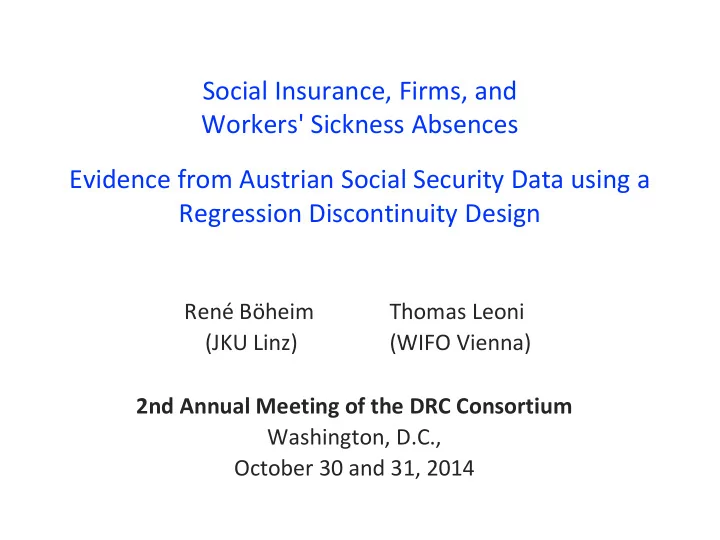

Social Insurance, Firms, and Workers' Sickness Absences Evidence from Austrian Social Security Data using a Regression Discontinuity Design René Böheim Thomas Leoni (JKU Linz) (WIFO Vienna) 2nd Annual Meeting of the DRC Consortium Washington, D.C., October 30 and 31, 2014
Our research Q: Do we observe fewer or shorter sickness absences in firms where absences costs are greater than in firms with lower costs? M: Quasi-experimental evaluation (RDD) with Austrian social security data for 1998 and 1999 R: Sickness absences do not differ in firms * with and without a 30%-deductible ( * firms close to the threshold)
Background Sickness absences are associated with a greater probability of receiving disability benefit (OECD 2010) Since the 1990s: increased importance of “integration measures” for sickness and disability policies, also aimed at employers Little evidence on how firms react to monetary incentives (Westergaard-Nielsen and Pertold 2012; Fevang, Markussen and Roed 2011)
Changing Firms’ Incentives Experience-rating: • Finland: no effect on DI (Kyyrä and Tuomala, 2013) • Netherlands: not clear as confounded with other changes (Koning, 2009) Other mechanisms: • Legal obligations • Deductibles (Co-payments)
Institutional Background Continued wage payment for all sick workers, 4 to 12 weeks (depending on tenure) Firms were insured against wage costs An administrative threshold (based on wage bill in t-2 ) defined whether a firm had to pay a deductible (30%) or not The quasi-experimental situation around the threshold provides causal evidence on the effect of the deductible on sickness absences for firms in this range (LATE)
Sorting? Note: Density of firms in the interval -1,500 and +1,500 around the threshold. The threshold was € 18,313.56 in 1998 and € 18,575.16 in 1999. Local polynomial regressions using a triangle kernel for each side of the cut-off (Kovak and McCrary, 2008).
Estimated effect on sickness incidences Note: Each dot indicates the estimated treatment effect on the number of sickness spells in a firm within € 1,500 of the thresholds. The grey lines indicate the 95 percent confidence intervals. Spells are all sickness absences of blue-collar workers in a firm in a month, weighted by the blue-collar workers' wage shares. Only spells are considered during which firms continued to pay their absent workers, without imposing an upper limit on the duration of a spell.
Key results We fail to reject the H0 of no effect : Note : τ indicates the estimated difference in the sickness indicator due to the change in treatment. Standard errors in parentheses. The optimal bandwidths are calculated according to Imbens (2012). The kernel is a triangle kernel. *** p<0.01, ** p<0.05, * p<0.1.
Discussion of Results • Medical certification? Probably not: Böheim and Leoni (2011) • Deductible too moderate to induce management responses? Probably: Size matters (Chiappori et al., 1998) • Deductible cheaper than alternative strategies? Possibly: Sick pay reciprocated by higher effort (Duersch et al., 2012) Austria’s system: similar to other countries (Germany!) BUT: We have to be careful when projecting our findings to other countries, particularly the US
In the US Different institutional setting: • lower benefit coverage, and • lower absenteeism Note: Data for workers aged 16 years+. Data for USA: CPS, BLS calculations; data for Austria: AKE, WIFO calculations.
Potential Implications • US firms more cost-sensitive? • Experience rating or similar incentives (Autor, 2011) might have stronger effects than in Austria? • Differential treatment of small and large firms • Results suggest that firms did not remain small due to the preferential treatment
Additional slides
Details of Austria’s System • Mandatory Social Security System • Continued wage payment: by law, for all sick workers, duration varies between 4 and 12 weeks and depends on tenure • Until 2001, firms received a refund of wages paid to sick blue-collar workers: • Small firms: 100% refund • Large firms: 70% refund (=30% deductible) • Size determined by wage bill in t-2
Choice of Bandwidth
Recommend
More recommend